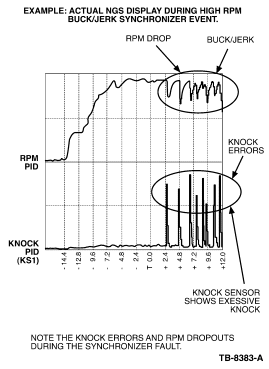| “This site contains affiliate links for which OEMDTC may be compensated” |
|
2000-2003 Taurus, Sable, Ranger vehicles equipped with a 3.0L 2-valve gas or FFV engine may exhibit a buck/jerk/miss during drive cycles above 3000 RPM with no diagnostic trouble codes (DTC’s).
A possible cause is the camshaft synchronizer assembly.
Since the camshaft position (CMP) fault monitor is not active above 2500 RPM, no diagnostic trouble code (P0340) is set during the drive concern, thus making it difficult to diagnose the root cause component.
ACTION:
Use an NGS or Scan Tool to identify whether or not the synchronizer is the causal component.
SERVICE PROCEDURE
- Select PID database.
- Select “Fuel Priority” PID database.
- Select KS1 and RPM PID’s.
- Capture data during drive symptom.
- Using graph mode, display KS1 and RPM.
- Look for knock errors which can be identified by rapidly rising peaks which correlate with drops in RPM (Figure 1).
- If the synchronizer assembly needs to be replaced, follow the appropriate model year Workshop Manual Removal and Installation procedure.
| PART NUMBER | PART NAME |
|---|---|
| F8DZ-12A362-AA | Synchronizer Assembly |
Figure 1
ADDITIONAL TIPS
The knock sensor PID does not use a specific unit (although the NGS displays a “V” after the numeric, it does not denote volts), the value displayed is strictly a number used to determine knock status by the strategy. Typically, the number will be between 25 and 125 with no fault or knock detected across the RPM range.
When the synchronizer fault occurs, the knock will increase rapidly, in most cases to its limit of 1023, but depending on the severity of the event, can range from the low hundreds to the 1023 limit. The key to identifying the synchronizer issue is the knock PID near or reaching the 1023 limit. In most cases of engine miss, detonation, etc. the knock will increase, but not reach 1023. Also note, if the CMP sensor is disconnected (open circuit fault), the knock PID is not updated and the value of the PID will be set to the 1023 limit.
 :
:


